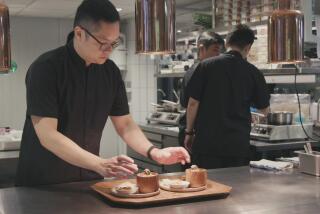Getting More Out of Singapore
- Share via
In the days when long hair was the fashion for young men, the word was out along the travel trail: If you arrived in Singapore with lengthy locks, you would probably be given the choice of a trim or a trip back out of the country. According to Carl Parkes, author of the “Singapore Handbook,” you can still see one of the original anti-hippie signs in a jazz club on Orchard Road.
If it seems odd to consider investing in a guidebook for a destination where the average stay is less than three days, rest assured that this one offers a lot of helpful information.
Parkes warns that backpacks should be avoided, “to sidestep the ‘hippie’ label foisted on backpackers,” and he suggests that “the modern solution is the travelpak, a combination bag that doubles as a backpack for easy portage but converts into a stylish shoulder bag when moving though customs and entering hotels.”
Dig further into the “Singapore Handbook” and you’ll learn that this tiny nation (only 253 square miles) at the tip of the Malay Peninsula has a variety of cultural curiosities. Although the skyline is filled with modern skyscrapers, designers still rely on experts in the ancient art of feng shui to determine the harmonious placement of windows, doors and furnishings.
Time your trip during special events and you can take in exotic festivities celebrated by a variety of different ethnic and religious groups.
Although the air fare to Singapore can be very expensive, Parkes points out that the destination might be more within reach of your budget-sized wallet than expected: “Two weeks in Asia can be surprisingly affordable since the high air fare to get there is easily offset by the relatively low cost of food and accommodations once you arrive. Budget travelers can spend as little as $10 per day for a basic bungalow and meals, or $20 to $30 per day for clean and comfortable bungalows with private baths and home-cooked meals.”
The author advises eating the foods of the region. “Savvy travelers can spend under $10 per day for three excellent meals; $15 to $20 per day in better cafes and local restaurants.”
You’ll find extensive, detailed information for working out your own economical walking tours and city sightseeing. Look for the less obvious, such as the “Night Safari at the Zoo.” It’s designed with a special lighting system using a blue-filter light, which lies in a part of the spectrum visible to the human eye but beyond the reach of most wildlife.
The handbook will also help you avoid local scams (for example, credit cards being removed from stored luggage and used by hotel staff) and give you more details on what you shouldn’t bring in (Playboy magazine to bubble gum) and on local restrictions (the banning of satellite dishes and censoring of cyberspace). You may learn some manners, too: “You must never lose your cool no matter how slow, mismanaged or disorganized the situation. Yelling and table-pounding will only screw things up for you--in fact, paper pushers enjoy slowing things up for the obnoxious foreigner.”
“The Singapore Handbook,” by Carl Parkes, is published by Moon Publications for $15.95.
Izon is a Toronto-based freelance writer. She can be reached at https://www.izon.com.
More to Read
Sign up for The Wild
We’ll help you find the best places to hike, bike and run, as well as the perfect silent spots for meditation and yoga.
You may occasionally receive promotional content from the Los Angeles Times.






